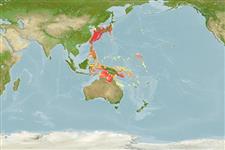Common names from other countries
Пластиножаберные (акулы и скаты) (sharks and rays) >
Carcharhiniformes (Ground sharks) >
Triakidae (Houndsharks) > Galeorhininae
Etymology: Hemitriakis: hemi-, from hemisys (Gr.), half, being a genus that Herre believed was “most closely related” to Triakis. (See ETYFish); japanica: -ica (L.), belonging to: Japan, type locality. (See ETYFish).
More on authors: Müller & Henle.
Environment: milieu / climate zone / depth range / distribution range
экология
морской демерсальный; пределы глубины 20 - 345 m (Ref. 86942). Subtropical; 40°N - 19°N, 112°E - 141°E
Northwest Pacific: China, Taiwan, Korea, and Japan. Nominal records from Ambon, Indonesia (unconfirmed and based on a specimen close to if not identical to Hemitriakis abdita) and New Caledonia (Ref. 13563).
Length at first maturity / Size / Вес / Возраст
Maturity: Lm 91.5, range 81 - 102 cm
Max length : 110 cm TL самец/пол неопределен; (Ref. 244); 120.0 cm TL (female); наибольший возраст (опубликованны данные): 15 годы (Ref. 9031)
Occurs close inshore and offshore down to at least 100 m depth. Presumably feeds on small fishes, cephalopods and crustaceans. Ovoviviparous, with 8 to 22 young in a litter. Size at birth about 20 to 21 cm. Utilized for human consumption.
Ovoviviparous, embryos feed solely on yolk (Ref. 50449).
Compagno, L.J.V., 1984. FAO Species Catalogue. Vol. 4. Sharks of the world. An annotated and illustrated catalogue of shark species known to date. Part 2 - Carcharhiniformes. FAO Fish. Synop. 125(4/2):251-655. Rome: FAO. (Ref. 244)
Статус Красного Списка МСОП (Ref. 130435)
CITES (Ref. 128078)
Not Evaluated
Угроза для людей
Harmless
Использование человеком
рыболовство: коммерческий
дополнительная информация
инструменты
Специальные отчеты
Скачать в формате XML
ресурсы в Интернет
Estimates based on models
Preferred temperature (Ref.
115969): 9.7 - 27, mean 20.2 (based on 252 cells).
Phylogenetic diversity index (Ref.
82804): PD
50 = 0.5156 [Uniqueness, from 0.5 = low to 2.0 = high].
Bayesian length-weight: a=0.00427 (0.00183 - 0.00992), b=3.04 (2.83 - 3.25), in cm Total Length, based on LWR estimates for this (Sub)family-body shape (Ref.
93245).
Trophic level (Ref.
69278): 4.4 ±0.4 se; based on diet studies.
устойчивость к внешним воздействиям (Ref.
120179): очень низкий, минимальное время удвоения популяции более 14 лет (Fec=8).
Fishing Vulnerability (Ref.
59153): High to very high vulnerability (72 of 100).
